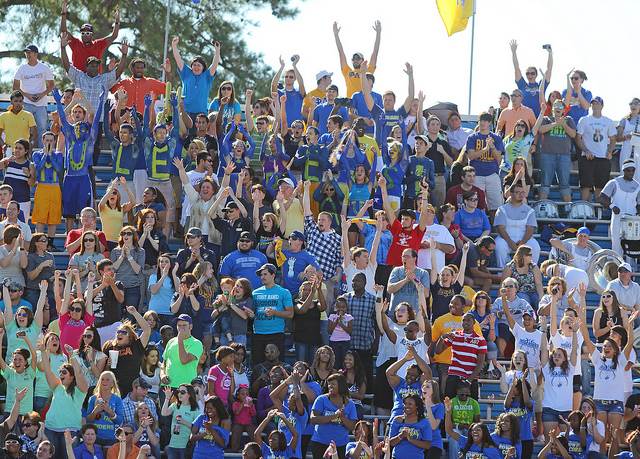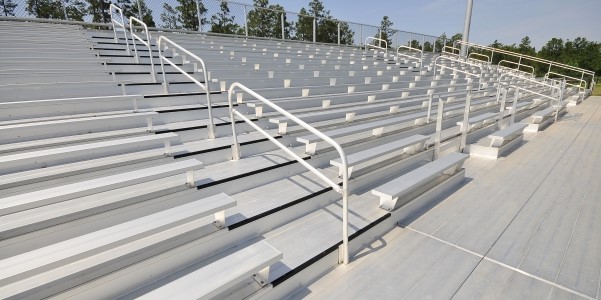The History and Evolution of Grandstands, From Stone Seats to Aluminum Bleachers

Grandstands have come a long way from stone seats and wooden planks to aluminum bleachers.
For local sporting events, how did spectators go from sitting on rocks to sitting on multi-tiered, elevated, IBC-compliant bleachers with ADA ramps to watch their children participate in competitions?
From the days of cavemen resting on their haunches near an open fire, humans have sought a place to gather, sit, relax, and share experiences, either for sporting events or the arts.
As those activities evolved from sitting around that fire into larger, more organized and well-attended spectator events, it became apparent that there was a need for additional space to accommodate all the interested onlookers.
Competing spaces were constructed so as to become the designated arenas where events would be held and also accommodate spectators. These events ranged from simple feats of strength from local or mythological heroes to more competitive, sporting style events or games, all played out in the openness of a simply constructed seating area, providing an egress and entrance at the open end.
Ancient Greece built it, and they came
The first officially titled stadium is noted as being constructed in ancient Greece, as early as the 8th century BC, with the capacity to hold up to 45,000 spectators.
In contrast, probably the most recognized venue, the well-known Roman Coliseum was constructed in the 1st century AD and can accommodate over 50,000 spectators. The Romans are given credit for leading the way in spectator seating improvements.
Their early versions of available seating and gathering spaces were arranged in the shape of a horseshoe wrapped around an open venue. But they also became adept at using available, adjacent hillsides for elevated viewing and better sightlines of the action, creating an early version of elevated aluminum bleachers.
Some went so far as to use available raw materials, mainly stone and marble, as a makeshift stairway, leading to the higher areas of bleachers made out of the same local materials.
Amphitheaters lead the way
But perhaps the greatest precursor to our current version of enclosed aluminum bleacher seating is the Roman amphitheater configuration like the Amphitheatre of Pompeii.
While previous seating design always featured an open-ended design, the Roman theater closed the circle of seating over the entrance and egress tunnels, maximizing capacity while creating a more intimate, interior area for performances or events. But this type of continued progress in design and accessibility was halted, and many venues abandoned when the highly anticipated Olympic games were suddenly canceled, said to be contrary to and even paganistic compared to the region’s overriding, popular, religious beliefs.
Renaissance brings resurgence of spectator-worthy events
Thanks to the Renaissance, the Olympics returned along with popular events, namely equestrian (jousting, chariot etc.) and foot running contests.
They were once again held in open areas with at least one open end, but many times both ends were left open to accommodate the access, egress, and overall running activity of the jousting horses.
These venues sported wooden tiered bleacher-type seating to accommodate those spectators considered important and most deserving.
Wood is good, but concrete is in the mix
By the late 1800s, we saw a noted increase in wooden grandstands being used to accommodate the increased attendance at the most popular sporting events, mainly boxing and horse racing.
Although they were uncomfortable at best, the wooden grandstands provided a common area for those that wanted to be present and see the events in person. The grandstands featured standing areas, a general, uncovered bleachers-type seating area for spectators, and then covered grandstands for the VIP attendees.
Wood construction was the norm, but the 1900s brought us the addition of concrete as well for use as seating options that became popular in football stadiums.
Concrete grandstands accounted for over 2500 grandstand structures, with a seating capacity of about 6 million.
The oldest, first built, most well known, and still functioning concrete constructed stadium is Harvard University’s Harvard Stadium, built in 1903. It’s known as the oldest permanent college sports structure.
It is many times compared to the old gladiator stadiums of ancient Greece and is credited with describing football as a gladiator sport, played on a gridiron.
It was considered sacred ground when built and is now considered a National Landmark. Most of the other concrete grandstands are also still in use as well.
The trend of multi-use fields means multi-use bleachers
The 1950s brought the trend of multi-use stadium construction, a one place catchall venue able to host sporting events like football and baseball, but also able to accommodate concerts and other large interest events.
With larger and more frequent crowds, the advancements in seating for bleachers moved towards sturdier steel structures, but still incorporated the popular wooden planks that were attached to the structure for the foot and seat boards, a common combination that can still be found today at some older places.
Then in 1965 brought us the Houston Astrodome, the iconic, enclosed playing field with the weird colored, fake grass. The designated “Eighth Wonder of The World” seated 70,000, and also marked the large-scale installation and use of manufactured aluminum bleacher seat boards.
This seating revelation proved to be a worthy and sensible replacement for many of those wooden planks and boards that were now nearing the end of their useful life and becoming rotting, splintering, safety hazards rather than a place to sit and watch a sporting event.
This historical structure is in the process of an architectural and design phase that will redevelop the Dome, keeping its history alive while hopefully setting the stage for even more historical moments.

Aluminum bleachers are now the standard for spectator seating and have replaced wooden grandstands.
Aluminum bleachers with I-Beam or angle frame construction
The progression continued into the 1970s, leading to permanent grandstands featuring the stronger, safer and non-flammable benefits of aluminum bleachers erected with either I-Beam or angle frame construction. The wood seating and foot planks were also replaced with aluminum, which by the way, is the most prevalent metal on earth.
This became the standard and preferred bleacher installation into the 1990s, partially because a series of catastrophic fires erupted in some of the older, wooden grandstands that still sported wooden plank seating.
The older wood materials, as they tend to do, turn into dried old lumber, creating an easy fire hazard because of their flammability. These grandstand fires, all having old wooden materials as the common cause, led to the demand for all non-flammable materials to be used in the construction of bleachers and grandstands. Aluminum bleachers require little maintenance and never require sanding and repainting. The metal is easily cleaned, most of the time with just soap and water.
Interlocking, welded deck construction is the best yet
An interlocking, all-welded aluminum bleacher decking system became prominent after the year 2000 and is now considered the industry standard.
While having an enclosed footing system to keep trash and litter from spreading to the grounds below, the individual extrusions interlock together and offer premium life spans. This system offers the rigidity and benefits of reinforced concrete without the maintenance.
It’s easy to see why an interlocking, welded structure has become the preferred installation. It has proven to be a very compatible partner to the accompanying, sometimes attached, press boxes, concession stands, or even restrooms.
And with interlocking aluminum bleacher decking, the configuration and layout of the seating can be changed, upgraded, or modified more readily, adapting to the facility’s needs over time.
As bleacher safety evolves, so will bleacher enhancements
Bleacher seating will continue to evolve to enhance the user experience, and new ideas will continually be implemented, as long as they meet the safety codes set forth by the ICC Standard on Bleachers, Folding and Telescopic Seating, and Grandstands, because safety is the best, most important, and least negotiable component of structures built for mass seating applications.
Aluminumbleachers.com offers a full range of bleachers for sale from low-rise 3 and 4-row bleachers to elevated 10 and 15-row bleachers and everything in between. If you need aluminum bleachers to be moved for different events at a facility, consider our portable bleachers. Tip and roll bleachers are great for indoor sporting or other events. In addition to aluminum bleachers, we also offer a full line of aluminum team benches, scorers tables, press boxes and picnic tables.
Written by Gerald Dlubala



